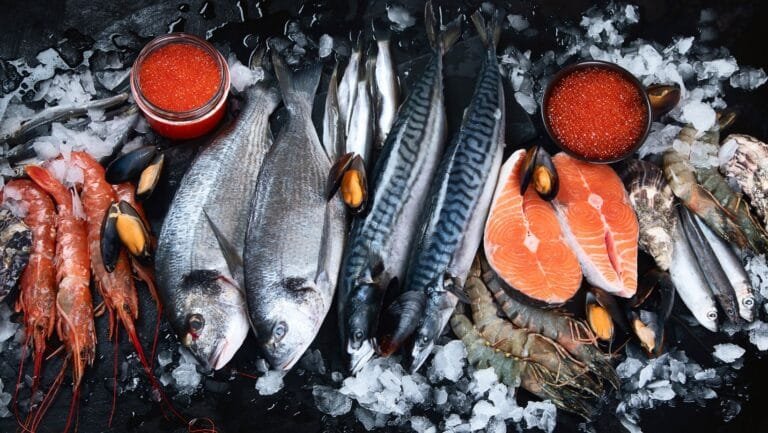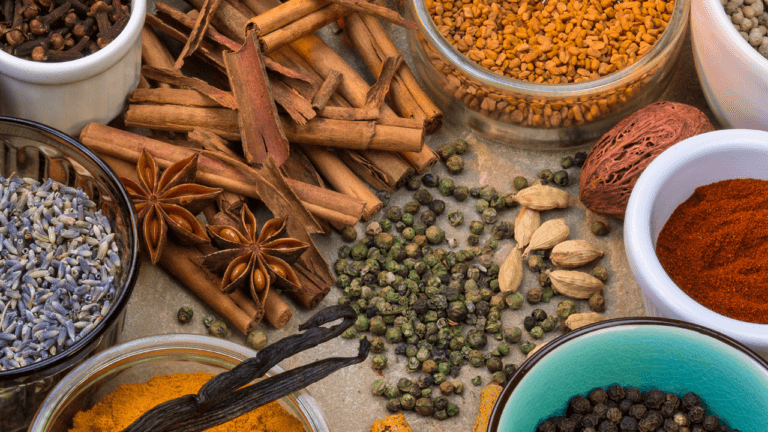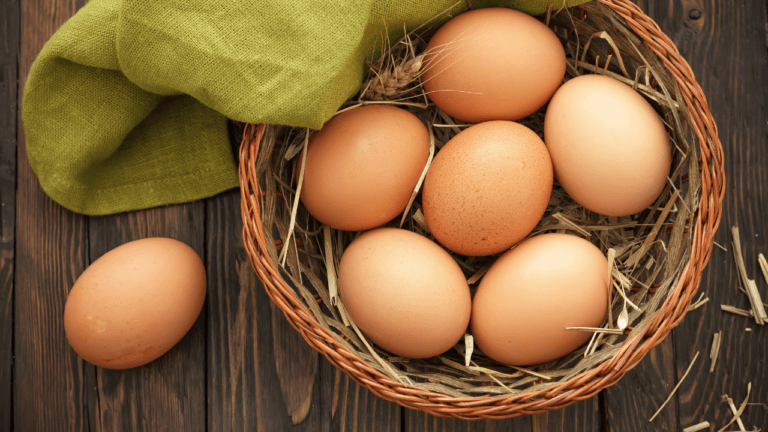Understanding Different Types of Salt: A Comprehensive Guide
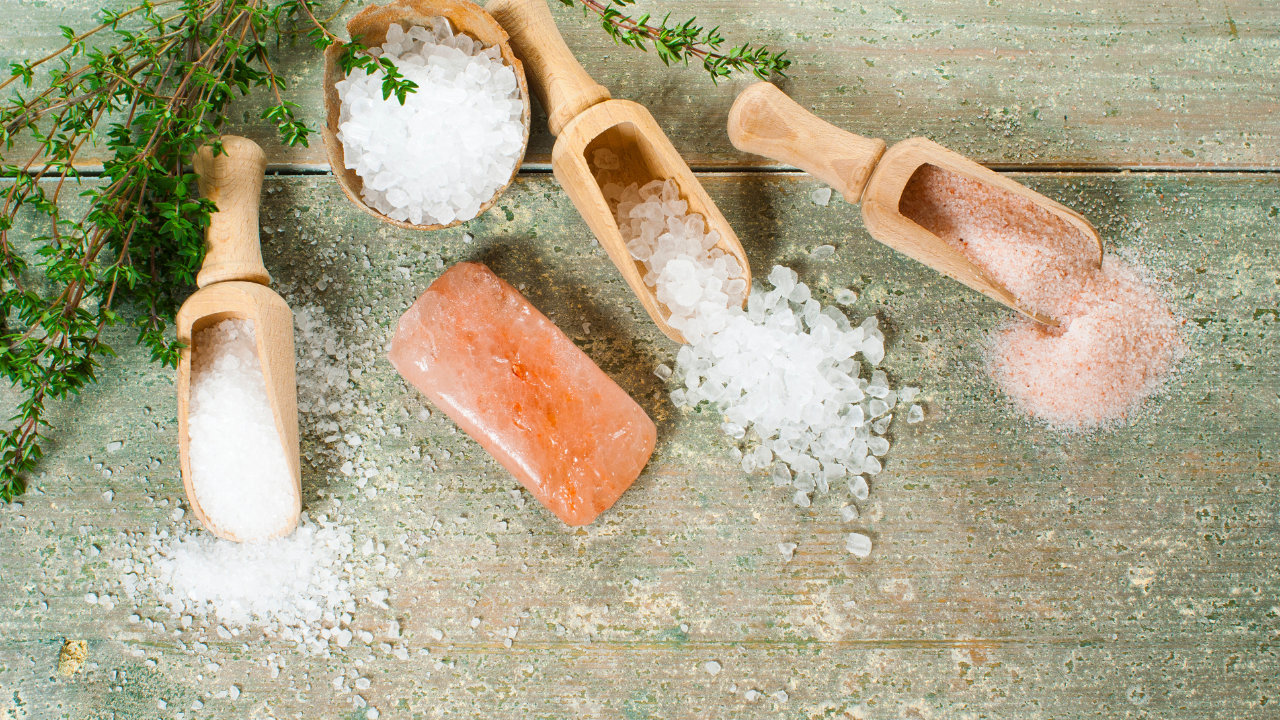
Some links on this page are affiliate links. This means we may earn a commission at no additional cost to you if you click through and make a purchase, you can check our Affiliate Disclosure. Thank you for your support!
Salt is more than just a kitchen staple – it’s a key ingredient in our diets and a fundamental part of cooking traditions around the world. In this post, we’re diving into the fascinating world of salt. We’ll explore the different types of it, why they matter, and how they can elevate your cooking. 🧂
The Historical Significance of Salt
Salt in Ancient Civilizations
Long ago, salt wasn’t just for seasoning food. It was a symbol of wealth and a crucial commodity for trade. Ancient Egyptians used it for mummification, and it even played a role in religious rituals in many cultures. Salt was so valuable in Rome that it was sometimes used as currency. Imagine buying something with a bag of salt today!
Evolution of Salt Production
The way we make salt has come a long way. Ancient methods included evaporating seawater in shallow pools, a method still used in some parts of the world. Over time, we developed mining techniques to extract rock salt from the earth. Today, advanced technologies allow us to produce salt in large quantities efficiently, but some artisans still make it the old-fashioned way, giving us a taste of history.
Stay tuned as we delve further into the various types of it and how each brings a unique flavor and texture to our plates. Understanding these differences can transform your cooking and maybe even your appreciation for this humble yet mighty mineral. 🍲🌟

Understanding the Chemistry of Salt
The Basic Composition
Let’s break down what salt really is. At its core, it is a combination of two elements: sodium and chlorine. When these two get together, they form sodium chloride (NaCl), which is the scientific name for common table salt. This combo is super stable and gives salt its unique properties.
But wait, there’s more to salt than just NaCl. Depending on where it comes from, salt can have a mix of other minerals too. These extras can change the way salt tastes, feels, and even looks.
How Different Salts Vary Chemically
When we talk about different types, we’re often talking about their unique ‘extras’. For example:
- Sea Salts: This one comes from evaporated seawater. It usually has bits of minerals like magnesium and calcium, which can add a slight mineral flavor.
- Himalayan Pink Salts: Its distinctive pink hue is a result of minute concentrations of iron oxide, or rust, in general. Its taste and texture differ from ordinary table salt because it contains additional minerals.
- Kosher Salts: What sets it apart isn’t so much its chemical makeup but its flaky, coarse structure. It’s great for seasoning because it’s easier to control how much you’re using.
So, when we think about different types of salt, it’s not just about sodium chloride. It’s about all the little extras that tag along, which can vary depending on where the salt is from and how it’s made. This is what gives each type of salt its unique character – a little something special for every dish. 🧂👩🍳🌍
Types of Salts and Their Characteristics
Table Salt: The Common Choice
It is the type most of us have in our kitchens. It’s usually mined from salt deposits and then processed to get rid of other minerals. This makes it very fine and uniform, perfect for everyday cooking and baking. It often has added iodine (good for thyroid health) and anti-caking agents to keep it from clumping. Use it for seasoning dishes, in baking, or just to sprinkle on your eggs in the morning. 🍳
Sea Salt: Nature’s Offering
It comes from evaporated seawater and keeps some trace minerals from the ocean. These minerals add subtle flavor differences. It can be fine or coarse and is great for finishing dishes – sprinkle it on top of foods right before serving for a flavor boost. It’s a favorite in salads, grilled meats, and even some desserts like salted caramel. 🌊🍽️
Himalayan Pink Salt: A Mineral-Rich Option

The pink color of this striking salt comes from old salt beds in the Himalayan mountains. The color comes from iron and other minerals. It’s less processed, so it retains these minerals. Himalayan pink salt is often used in the same way as sea salt but is also popular for decorative salt grinders and even in spa treatments. It’s a hit for both its nutritional value and aesthetic appeal. 💖
Kosher Salt: More Than Just a Religious Significance
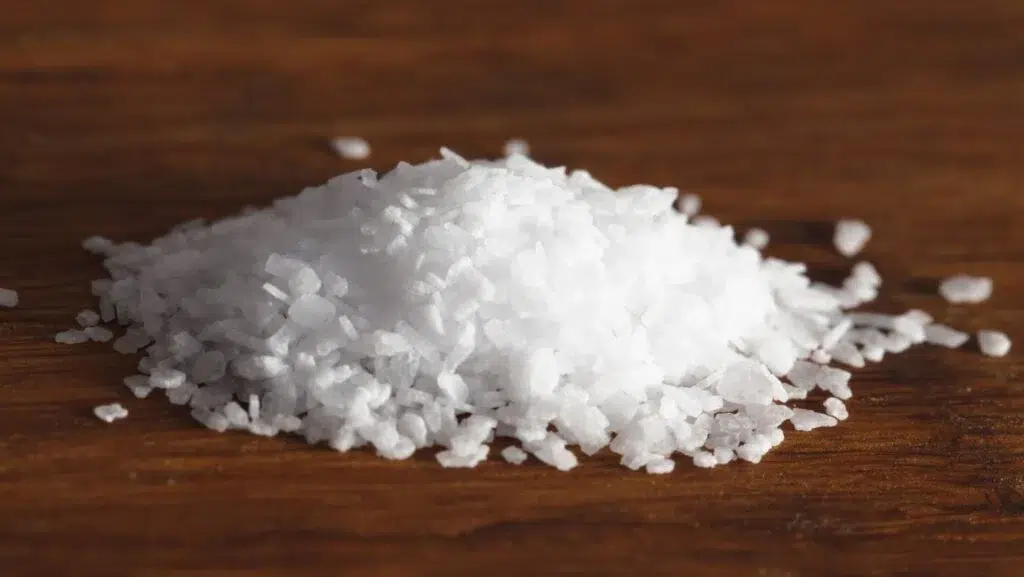
Don’t let the name fool you – kosher salt isn’t just for kosher diets. It’s named for its use in the koshering process of meats. It has a larger, flakier crystal than table salt, which makes it great for seasoning before cooking. Chefs love it because the larger grains are easier to pick up and sprinkle evenly. It’s a go-to for marinating meats and sprinkling on veggies. 🥩🥦
Specialty Salts: Exploring Exotic Varieties
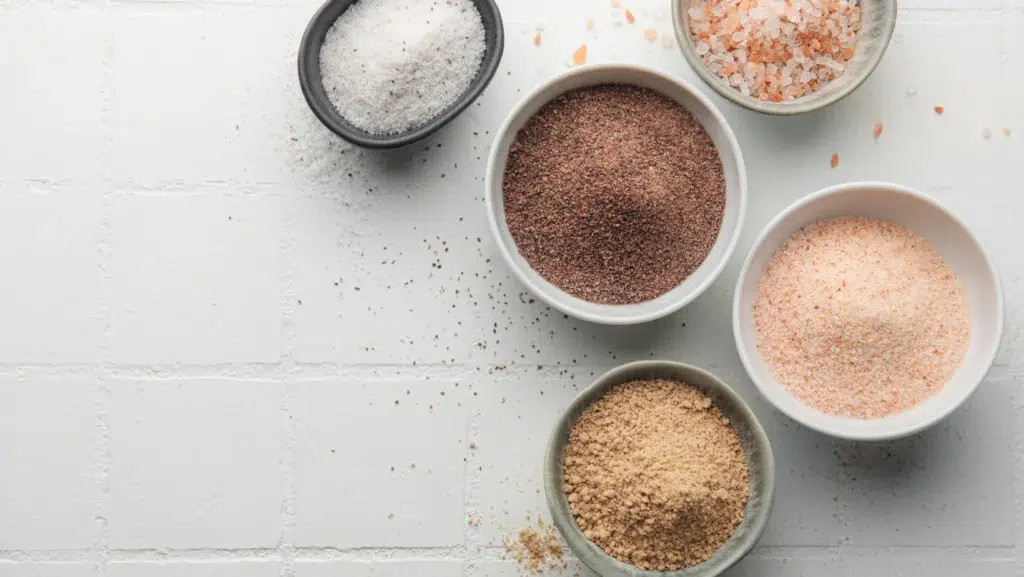
Then there are the more unique types of salt, like black salt, smoked salt, and even volcanic salt. These salts come from specific places or are made using special techniques. For example, black salt from Hawaii gets its color from activated charcoal, adding a unique flavor and detox properties. Smoked salt is slowly smoked over wood fires to infuse a smoky flavor, perfect for BBQs. These exotic salts are fun to experiment with and can add an unexpected twist to your dishes. 🌋🍖
Each type of it brings its own character to the table, making it easy to spice up your cooking routine. So, next time you reach for i, think about which one will best suit your dish! 🧂🍲👨🍳
Culinary Uses of Different Salts
How to Choose the Right Salt for Cooking
Selecting the right type of salt can really elevate your cooking. Here are some quick tips:
- Table Salt: Ideal for everyday cooking and baking because of its fine texture. It dissolves easily, making it perfect for soups, sauces, and dressings.
- Sea Salt: Its coarser grains and unique mineral content make it great for finishing dishes. Sprinkle it over salads, grilled veggies, or even chocolate desserts for a flavor boost.
- Himalayan Pink Salt: Use it in dishes where you want a subtle, earthy flavor. It’s also great in salt grinders for a fresh sprinkle over meals.
- Kosher Salt: Its larger flakes are perfect for seasoning meat. The coarse texture lets you control how much salt you’re adding, making it ideal for rubs and marinades.
Remember, different salts have different levels of saltiness, so you might need to adjust the amounts based on the type you’re using. A little experimentation can lead to delicious discoveries! 🍳🧂
Salt in Baking: More Than Just a Flavor Enhancer
Salt in baking isn’t just about adding flavor; it’s a key player in the science of baking. Here’s why it’s important:
- Enhances Flavor: Salt brings out the flavors of other ingredients, making your baked goods taste more complex.
- Controls Yeast: In bread making, salt regulates yeast fermentation, ensuring your bread rises just the right amount.
- Strengthens Gluten: Salt strengthens gluten in dough, giving breads and pastries the right texture.
- Improves Shelf Life: It helps to keep baked goods fresher for longer by controlling moisture.
So, next time you’re baking, don’t skip the salt! It does much more than just add flavor; it’s essential for texture, rise, and even shelf life of your baked treats.
Health Implications of Salt Consumption
Understanding Sodium Intake and Health
Salt is essential for our bodies, but it’s all about balance. Sodium, a key component of it, helps maintain fluid balance and is vital for nerve and muscle function. On the other hand, an excess of sodium can cause health problems such as hypertension, a risk factor for heart attacks and strokes.
Less than 2,300 milligrams of sodium per day, or about one teaspoon of table salt, is the recommended daily intake. But remember, most of our sodium intake comes from processed and restaurant foods, not just the salt shaker!
Choosing Healthier Salt Options
If you’re looking to make healthier choices, here’s what you can do:
- Read Labels: Pay attention to the sodium content in processed foods. Opt for low-sodium versions when available.
- Flavor with Herbs and Spices: Instead of relying solely on salt for flavor, experiment with a variety of herbs and spices. They can add great taste without the extra sodium.
- Try Different Salt Types: Because of their larger crystals, some salts, like sea salt and Himalayan pink salt, have less sodium by volume and trace minerals when compared to table salt.
- Use Salt Wisely: When cooking, add salt in stages and taste as you go. Often, a little goes a long way.
- Be Mindful of Salt in Eating Out: Restaurant food is often high in sodium. When possible, ask for dishes to be made with less salt.
Remember, it’s not about cutting out salt completely – it’s about finding the right balance that works for your body and taste buds. Happy, healthy eating! 🥦🧂💓
The Future of Salt: Trends and Innovations
Sustainable Salt Production
As we become more aware of our environmental impact, sustainable salt production is gaining traction. Here’s what’s happening:
Solar Evaporation Ponds: These use the power of the sun and wind to evaporate water, leaving behind salt. This method is energy-efficient and has a lower carbon footprint.
Recycling Saltwater: Some innovative companies are exploring ways to recycle saltwater from other industrial processes, reducing waste and conserving resources.
Wild Harvesting: This approach involves collecting sea salt from natural pools and areas with minimal environmental disturbance. It’s all about working with nature, not against it.
These methods not only help protect the environment but also produce unique salts that can add a special touch to your cooking.
Innovative Uses of Salt in Cuisine and Beyond
Salt isn’t just for seasoning anymore. Check out these cool, new ways people are using different types:
- Salt Pairings: Just like wine, certain salts pair beautifully with specific foods. For instance, try flaky sea salt on dark chocolate – it’s a game-changer!
- Salt Blocks for Cooking: Cooking on Himalayan salt blocks adds a subtle saltiness to food and makes for a stunning presentation.
- Health and Wellness: Beyond the kitchen, it is like Epsom and Himalayan are popular in spa treatments for their mineral content and therapeutic properties.
- Craft Cocktails: Bartenders are using it to enhance and balance the flavors in their drink creations, from salt-rimmed glasses to salt-infused syrups.
The world of salt is full of surprises. From sustainable production to innovative culinary uses, it continues to be an exciting and essential part of our lives. So, next time you reach for that salt-shaker, remember, there’s a whole world of salty innovation out there! 🌍🧂🍹
ALSO READ: Ignite Your Kitchen Confidence with Kitchen Safety Essentials
Conclusion
So, we’ve taken a savory journey through the diverse world of salt, uncovering the unique qualities and uses of various types of salt. From the common table salt to the exotic Himalayan pink and everything in between, each type of salt brings its own flair to the table.
Remember, salt is more than just a seasoning – it’s a world of flavor, history, and innovation waiting to be explored. Whether you’re a seasoned chef or a home cook, experimenting with different salts can transform your dishes in exciting ways.
Go ahead, play around with sea salt in your salads, sprinkle some Himalayan pink on your grilled veggies, or try kosher salt for your next batch of cookies. There are countless options, and your palate will appreciate it.
Let’s not just stick to the salt we know. Let’s shake things up a bit, explore the many types of salt out there, and discover how each can elevate our cooking to new, delicious heights. Happy seasoning! 🧂🍳🥗
ALSO READ: Unlock the Secrets to Picking The Right Kitchen Appliances for Home Chefs
FAQs about Salt
- What makes table salt different from sea salt?
- Sea salt has a distinct flavor and texture because it is made by evaporating seawater while retaining trace minerals. Mined from subterranean salt deposits, table salt typically undergoes more extensive processing to remove minerals and add anti-caking agents.
- Is pink Himalayan salt superior to ordinary salt?
- “Better” depends on your preference and needs. Himalayan pink salt contains trace minerals, giving it a unique flavor and pink color. Nutritionally, these minerals are present in very small amounts, so the health benefits are often considered minimal compared to regular salt.
- Can salt expire or go bad?
- Salt itself doesn’t expire or go bad. However, added ingredients, like iodine in iodized salt, can reduce its shelf life. Also, if salt absorbs moisture or contaminants from the environment, it can clump or change in texture.
- How much salt should I consume daily?
- For most adults, especially those with high blood pressure, the American Heart Association suggests no more than 2,300 milligrams daily, with 1,500 mg being the ideal daily limit.
- Does kosher salt taste different from regular salt?
- Kosher salt typically doesn’t taste different from regular table salt, but it has a coarser grain and is less salty by volume. Its flaky texture makes it easier to control the amount of saltiness in your cooking.
- Why is reducing salt intake important for health?
- Excessive consumption is linked to an increased risk of high blood pressure, heart disease, and stroke. Reducing salt intake can help manage or prevent these conditions.
- Are there substitutes for people with dietary restrictions?
- Yes, there are salt substitutes that use potassium chloride instead of sodium chloride, suitable for those looking to reduce sodium intake. However, they should be used cautiously, especially by those with kidney problems or on certain medications.
- Can I use it in baking?
- Absolutely! It is a crucial ingredient in baking. It enhances flavor, strengthens gluten, controls yeast action, and can even affect the texture and rise of baked goods.
- What are some ways to reduce salt in my diet?
- Use herbs and spices for flavor, choose fresh or unprocessed foods, read labels to choose lower-sodium products, and be cautious with it in cooking and at the table.
- Are all sea salts the same?
- No, it can vary based on where they are harvested and their processing. This results in different textures, flavors, and mineral contents.
ALSO READ: Sustainable Savvy: Mastering Eco-Friendly Kitchen Habits That Matter
Remember, while salts is essential in our diets, the key is to use it mindfully and in moderation. 🧂


